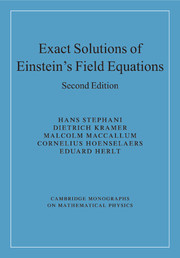Book contents
- Frontmatter
- Contents
- Preface
- List of tables
- Notation
- 1 Introduction
- Part I General methods
- Part II Solutions with groups of motions
- 11 Classification of solutions with isometries or homotheties
- 12 Homogeneous space-times
- 13 Hypersurface-homogeneous space-times
- 14 Spatially-homogeneous perfect fluid cosmologies
- 15 Groups G3 on non-null orbits V2. Spherical and plane symmetry
- 16 Spherically-symmetric perfect fluid solutions
- 17 Groups G2 and G1 on non-null orbits
- 18 Stationary gravitational fields
- 19 Stationary axisymmetric fields: basic concepts and field equations
- 20 Stationary axisymmetric vacuum solutions
- 21 Non-empty stationary axisymmetric solutions
- 22 Groups G2I on spacelike orbits: cylindrical symmetry
- 23 Inhomogeneous perfect fluid solutions with symmetry
- 24 Groups on null orbits. Plane waves
- 25 Collision of plane waves
- Part III Algebraically special solutions
- Part IV Special methods
- Part V Tables
- References
- Index
23 - Inhomogeneous perfect fluid solutions with symmetry
from Part II - Solutions with groups of motions
Published online by Cambridge University Press: 10 November 2009
- Frontmatter
- Contents
- Preface
- List of tables
- Notation
- 1 Introduction
- Part I General methods
- Part II Solutions with groups of motions
- 11 Classification of solutions with isometries or homotheties
- 12 Homogeneous space-times
- 13 Hypersurface-homogeneous space-times
- 14 Spatially-homogeneous perfect fluid cosmologies
- 15 Groups G3 on non-null orbits V2. Spherical and plane symmetry
- 16 Spherically-symmetric perfect fluid solutions
- 17 Groups G2 and G1 on non-null orbits
- 18 Stationary gravitational fields
- 19 Stationary axisymmetric fields: basic concepts and field equations
- 20 Stationary axisymmetric vacuum solutions
- 21 Non-empty stationary axisymmetric solutions
- 22 Groups G2I on spacelike orbits: cylindrical symmetry
- 23 Inhomogeneous perfect fluid solutions with symmetry
- 24 Groups on null orbits. Plane waves
- 25 Collision of plane waves
- Part III Algebraically special solutions
- Part IV Special methods
- Part V Tables
- References
- Index
Summary
In this chapter we cover those solutions containing a perfect fluid, and admitting at least an H1 and at most an H3, which are not discussed elsewhere. Most of the known solutions admit a G2I acting on spacelike orbits, and can be considered to be cosmologies. Vacuum and Einstein–Maxwell solutions with a G2 on S2 in which the gradient of the W of (17.4) is timelike may also ipso facto be called cosmological. In this book, they and vacua with a G1 are covered by Chapters 17–22, 25 and 34.
Solutions with a Gr, r ≥ 3, are discussed in Chapters 13–16: see the tables in §13.5. Relations between them, in vacuum, Einstein–Maxwell and stiff fluid cases, arise from applying generating techniques when the G3 contains a G2I (see §10.11, Chapter 34 and, e.g., Kitchingham (1986)). Stationary axisymmetric fluid solutions appear in Chapter 21.
Theorem 10.2 enables one to generate an infinity of solutions with a G2I on S2 and equation of state p = μ from vacuum solutions. Vacua and stiff fluids with a G2I on S2 obtainable using the methods of Chapters 10 and 34 have been surveyed by e.g. Carmeli et al. (1981), Krasiński (1997) and Belinski and Verdaguer (2001).
- Type
- Chapter
- Information
- Exact Solutions of Einstein's Field Equations , pp. 358 - 374Publisher: Cambridge University PressPrint publication year: 2003

